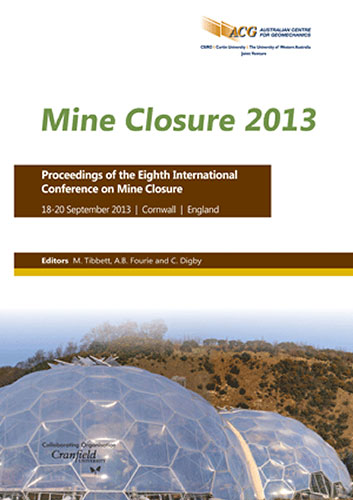An adaptable and dynamic management strategy for the treatment of polluted mine water from the abandoned Wheal Jane Mine, Cornwall, UK

|
Authors: Wyatt, LM; Watson, IA; Kershaw, S; Moorhouse, AML |
DOI https://doi.org/10.36487/ACG_rep/1352_07_Wyatt
Cite As:
Wyatt, LM, Watson, IA, Kershaw, S & Moorhouse, AML 2013, 'An adaptable and dynamic management strategy for the treatment of polluted mine water from the abandoned Wheal Jane Mine, Cornwall, UK', in M Tibbett, AB Fourie & C Digby (eds), Mine Closure 2013: Proceedings of the Eighth International Seminar on Mine Closure, Australian Centre for Geomechanics, Cornwall, pp. 69-78, https://doi.org/10.36487/ACG_rep/1352_07_Wyatt
Abstract:
Following the closure of Wheal Jane Mine in 1991, the mine water was allowed to recover and flood the mine workings. In 1992 a release of contaminated, acidic metal-rich (i.e., Fe, Zn, As, Mn, Al, Cu, Cr and Cd) mine water discharged into the River Carnon; in turn, this flowed into the Fal Estuary, causing a large, visual plume within the estuary at Falmouth. After this pollution incident, the National Rivers Authority (later part of the Environment Agency) established a temporary treatment plant and initiated the process of developing a long-term treatment plant. In 2000, the current active mine water pumping and treatment plant was completed, and operations started to remove the contaminants through chemical (lime) dosing using a series of treatment tanks. Prior to April 2011, this operational aspect of the plant was managed, under contract, by the Environment Agency. Since its inception in 1994, the Coal Authority has constructed and currently operates over 60 mine water remedial schemes for treating contaminated coal mine water. In 2011 the Authority was granted permission to take on work regarding non-coal types of mine water, which led to its managing the Wheal Jane Scheme on behalf of the Environment Agency. The knowledge and expertise at the Coal Authority allowed for a much needed assessment of the existing pumping and treatment regimes at the plant in addition to investigating the wider mining catchment as a whole. The main focus of this assessment was to identify any cost savings and efficiencies, thereby making continuous improvements to the scheme and gaining additional wider knowledge for the site. To date, since 2011 the Coal Authority and Veolia Water have implemented changes resulting in lime savings of 7% and polymer savings of 30% whilst continuing to meet all environmental consents. In addition to this, the Authority has undertaken an appraisal of the geochemistry of the water and begun a regional monitoring network of shaft water levels within the catchment to aid understanding and enable future possible scenarios for the plant to be assessed. Currently the Authority envisages a future in which changes in the mine water pumping regime could result in pumping less water and, in the long term, the establishment of a passive treatment scheme. This would ultimately reduce the financial burden of both active treatment and pumping. The Wheal Jane mine site sits within a larger catchment, which in part is drained by the Great County Adit. The discharge from the County Adit also flows in to the River Carnon, causing additional environmental issues. Together with the scheme at Wheal Jane, the investigations undertaken by the Coal Authority could also see some improvements being made to metal contamination originating from the County Adit.
References:
Brown, M., Barley, B. and Wood, H. (2002) Minewater Treatment Technology, Application and Policy, IWA Publishing, 453 p.
CL:AIRE (2004) Mine water treatment at Wheal Jane tin mine Cornwall, Case Study Bulletin (CSB4).
Coulton, R., Bullen, C., Dolan, J., Hallett, C., Wright, J. and Marsden, C. (2003) Wheal Jane mine water active treatment design construction and operation, Land Contamination & Reclamation, Vol. 11(2), pp. 245–252.
Hallberg, K.B. and Johnson, D.B. (2003) Passive mine water treatment at the former Wheal Jane tin mine, Cornwall: important biogeochemical and microbiological lessons, Land Contamination & Reclamation, Vol. 11(2), pp. 213–220.
Hamilton, R. (1993) The impact of discharges from Wheal Jane and abandoned tin mine on environmental water quality in south west England, in Congress Proceedings, 1st SETAC World Congress, Lisbon, Portugal, pp. 28–31.
Knight Piésold (1993) Wheal Jane Minewater Study Data Monitoring Review, Report for National Rivers Authority, 33 p.
Knight Piésold (WS Atkins) (1996) Historical Data Report – Wheal Jane Minewarter project Consultancy Studies 1996–1999, Report for Environment Agency, 53 p.
Knight Piésold (WS Atkins) (1998) Appraisal and Selection of the Long Term Treatment Option – Wheal Jane Minewarter Project Consultancy Studies 1996–1999, Report for Environment Agency, 104 p.
Marcus Hodges Environmental Ltd (1991) Wheal Jane Hydrogeological Impact Assessment – Assessment of Mine Drainage and Options for Mine Water Treatment, Report for National River Authority Southwest Region, 46 p.
Siltbuster (2011) Process Review Report in 2011 for the Wheal Jane Treatment Plant, Prepared for the Coal Authority, 29 p.
URS (2010) Wheal Maid Tailings Lagoon Further Assessment Actions under Part 2A of the Environmental Protection Act 1990 Seriousness of Pollution, Report for Environment Agency, 277 p.
Watermeyer, Legge, Piesold & Uhlmann (1980) Final Report on the Investigation of Water Infiltration to the Mine, prepared for Carnon Consolidated Tin Mines Ltd. Wheal Jane Mine, 117 p.
Whitehead, P.G. and Prior, H. (2005) Bioremediation of acid mine drainage: an introduction to the Wheal Jane wetlands project, Science of the Total Environment, Vol. 338(1–2), pp. 15–21.
WYG (2011) Mine Water Pollution in the Carnon River Catchment 2009–2010, Project Carnon, Report for Environment Agency, 37 p.
Younger, P.L. (2000) The adoption and adaption of passive treatment technologies for the mine waters in the United Kingdom, Mine Water and the Environment, Vol. 19, pp. 84–97.
Younger, P.L. (2002) Mine water pollution from Kernow to Kwazulu-Natal: geochemical remedial options and their selection in practice, Geoscience in Southwest England, Vol. 10, pp. 255–266.
© Copyright 2025, Australian Centre for Geomechanics (ACG), The University of Western Australia. All rights reserved.
View copyright/legal information
Please direct any queries or error reports to repository-acg@uwa.edu.au
View copyright/legal information
Please direct any queries or error reports to repository-acg@uwa.edu.au